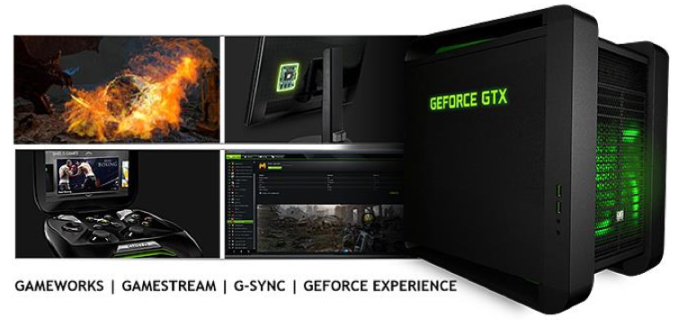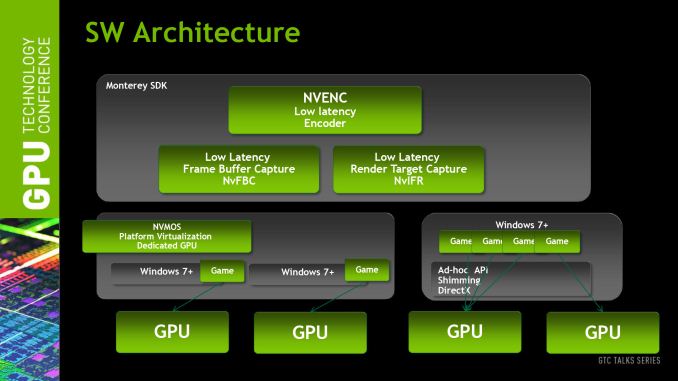The NVIDIA GeForce GTX 750 Ti and GTX 750 Review: Maxwell Makes Its Move
by Ryan Smith & Ganesh T S on February 18, 2014 9:00 AM ESTMaxwell’s Feature Set: Kepler Refined
To start our look at the Maxwell architecture, we’ll start with a look at the feature set, as this will be the shorter and easier subject to begin with.
In short, Maxwell only offers a handful of new features compared to Kepler. Kepler itself was a natural evolution of Fermi, further building on NVIDIA’s SM design and Direct3D 11 functionality. Maxwell in turn is a smaller evolution yet.
From a graphics/gaming perspective there will not be any changes. Maxwell remains a Direct3D 11.0 compliant design, supporting the base 11.0 functionality along with many (but not all) of the features required for Direct3D 11.1 and 11.2. NVIDIA as a whole has not professed much of an interest in being 11.1/11.2 compliant – they weren’t in a rush on 10.1 either – so this didn’t come as a great surprise to us. Nevertheless it is unfortunate, as NVIDIA carries enough market share that their support (or lack thereof) for a feature is often the deciding factor whether it’s used. Developers can still use cap bits to access the individual features of D3D 11.1/11.2 that Maxwell does support, but we will not be seeing 11.1 or 11.2 becoming a baseline for PC gaming hardware this year.
On the other hand this means that for the purposes of the GeForce family the GTX 750 series will fit in nicely into the current stack, despite the architectural differences. As a consumer perspective is still analogous to a graphics perspective, Maxwell does not have any features that will explicitly set it apart from Kepler. All 700 series parts will support the same features, even NVIDIA ecosystem features such as GameWorks, NVENC, and G-Sync, so Maxwell is fully aligned with Kepler in that respect.
At a lower level the feature set has only changed to a slightly greater degree. I/O functionality is identical to Kepler, with 4 display controllers backing NVIDIA’s capabilities. HDMI 1.4 and DisplayPort 1.2 functionality join the usual DVI support, with Maxwell being a bit early to support any next generation display connectivity standards.
Video Encode & Decode
Meanwhile turning our gaze towards video encoding and decoding, we find one of the few areas that has received a feature upgrade on Maxwell. NVENC, NVIDIA’s video encoder, has received an explicit performance boost. NVIDIA tells us that Maxwell’s NVENC should be 1.5x-2x faster than Kepler’s NVENC, or in absolute terms capable of encoding speeds 6x-8x faster than real time.
For the purposes of the GTX 750 series, the impact of this upgrade will heavy depend on how NVENC is being leveraged. For real time applications such as ShadowPlay and GameStream, which by the very definition can’t operate faster than real time, the benefit will primarily be a reduction in encoding latency by upwards of several milliseconds. For offline video transcoding using utilities such as Cyberlink’s MediaEspresso, the greater throughput should directly translate into faster transcoding.
The bigger impact of this will be felt in mobile and server applications, when GM107 makes its introduction in those product lines. In the case of mobile usage the greater performance of Maxwell’s NVENC block directly corresponds with lower power usage, which will reduce the energy costs of using it when operating off of a battery. Meanwhile in server applications the greater performance will allow a sliding scale of latency reductions and an increase in the number of client sessions being streamed off of a single GPU, which for NVIDIA’s purposes means they will get to increase the client density of their GRID products.
Speaking of video, decoding is also receiving a bit of a lift. Maxwell’s VP video decode block won’t feature full H.265 (HEVC) support, but NVIDIA is telling us that they will offer partial hardware acceleration, relying on a mix of software and hardware to decode H.265. We had been hoping for full hardware support on Maxwell, but it looks like it’s a bit premature for that in a discrete GPU. The downside to this is that the long upgrade cycle for video cards – many users are averaging 4 years these days – means there’s a good chance that GTX 750 owners will still be on their GTX 750 cards when H.265 content starts arriving in force, so it will be interesting to see just how much of the process NVIDIA can offload onto their hardware as it stands.
H.265 aside, video decoding overall is getting faster and lower power. NVIDIA tells us that decoding is getting a 8x-10x performance boost due to the implementation of a local decoder cache and an increase in memory efficiency for video decoding. As for power consumption, combined with the aforementioned performance gains, NVIDIA has implemented a new power state called “GC5” specifically for low usage tasks such as video playback. Unfortunately NVIDIA isn’t telling us much about how GC5 works, but as we’ll see in our benchmarks there is a small but distinct improvement in power consumption in the video decode process.












177 Comments
View All Comments
MrSpadge - Tuesday, February 18, 2014 - link
To be fair GTX650Ti Boost consumes ~100 W in the real world. Still a huge improvement!NikosD - Tuesday, February 18, 2014 - link
Hello.I have a few questions regarding HTPC and video decoding.
Can we say that we a new video processor from Nvidia, a new name like VP6 or more like a VP5.x ?
How Nvidia is calling the new video decoder ?
Why don't you add a 4K60 fps clip in order to test soon to be released HDMI 2.0 output ?
If you run a benchmark using DXVA Checker between VP5 and VP6 (?) how much faster is VP6 in H.264 1080p, 4K clips ?
Thanks!
Ryan Smith - Thursday, February 20, 2014 - link
NVIDIA doesn't have a name for it; at least not one they're sharing with us.NikosD - Thursday, February 20, 2014 - link
Thanks.Is it possible to try a 4K60fps with Maxwell ?
I wonder if it can decode it in realtime...
Flunk - Tuesday, February 18, 2014 - link
I think these will be a lot more exciting in laptops. Even if they're no where near Nvidia's claimed 2x Kepler efficiency per watt. On the desktop it's not really that big a deal. The top-end chip will probably be ~40% faster than the 780TI but that will be a while.dylan522p - Tuesday, February 18, 2014 - link
the 880 will be much more powerful than the 780ti. More than 40% even. They could literally die shrink and throw a few more SMX's and the 40% would be achieved. I would imagine either they are gonna have a HUGE jump (80% +) or they are gonna do what they did with Kepler and release a 200W Sku that is about 50% faster and when 20nm yields are good enough have the 900 series come with 250W Skus.Kevin G - Tuesday, February 18, 2014 - link
Very impressive performance for its power consumption. I can see an underclocked version of this card coming with a passive cooler for HTPC solutions. Perhaps that'd be a hypothetical GT740? I'm surprised that nVidia hasn't launched a mobile version of this chip. It seems like it'd be ideal for midrange laptops that still have discrete graphics.I suspect that the extra overclocking headroom is in reserve for a potential rebrand to a GTX 800 series product. (Though a straight die shrink of this design to 20 nm would provide even more headroom for a GTX 800/900 card.) nVidia could have held back to keep it below the more expensive GTX 660.
Though ultimately I'm left wanting the bigger GM100 and GM104 chips. We're going to have to wait until 20 nm is ready but considering the jump Maxwell has provided in the low end of the market, I'm eager to see what it can do in the high end.
DanNeely - Tuesday, February 18, 2014 - link
ASUS has a 65W TDP GT 640 with a big 2 slot passive heat sink (GT640-DCSL-2GD3); with the 750 Ti only hitting 60W a passive version of it should be possible at near stock performance. I suspect the 740 will be a farther cut down 3 SMM model which might allow a single slot passive design.PhoenixEnigma - Tuesday, February 18, 2014 - link
Passive cooling was my first thought as well - I've been looking for something to replace the 6770 in my HTPC with, and I wanted something both faster and passively cooled. There are already passive 7750s on the market, and the numbers in Bench put the 750Ti at about 9W more than then 7750 under real world load, so a vanilla 750 with a passive cooler should be entirely possible. Even a 750Ti might be doable, but that could be pushing things a little far.evilspoons - Tuesday, February 18, 2014 - link
I need a new half-height HTPC card, my 2.5 year old Asus Radeon 6570 bit the dust last month (sparkly picture, one particular shade of grey turned random colours). If they can work out the kinks in this thing and underclock it a bit, it sounds like a good candidate.It feels like it's been a long time since anything new showed up in the half-height video card game.